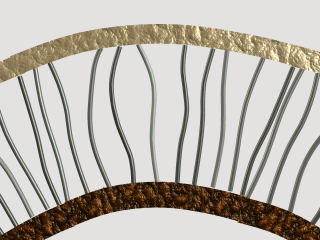Monday, May 06, 2019
Not just a BIG finding. This is an EARTHQUAKE.
Via Eurekalert:
 The new part here is that the thalamus predetermines the angles and destinations of those railroads by sending guide waves. LORAN. This whole process happens in a short time, around the 16th day of a mouse's 20-day gestation period, so it might be around the 220th day for humans. Any disruption around that time could lead to a messed-up map. Overly broad destinations or jumbled destinations. In other words, CP.
The new part here is that the thalamus predetermines the angles and destinations of those railroads by sending guide waves. LORAN. This whole process happens in a short time, around the 16th day of a mouse's 20-day gestation period, so it might be around the 220th day for humans. Any disruption around that time could lead to a messed-up map. Overly broad destinations or jumbled destinations. In other words, CP.
How are the neurons of the somatosensory cortex organized during development to perform these functions? Neurons of this brain region, as in the rest of the cerebral cortex, are assembled into columns that are placed next to each other like building bricks. It remains unknown, however, how these columnar structures become functional correspondents of the distant regions of the periphery. Although some studies highlight the role of genetic factors to form initial columns, most studies in the past decade have emphasized that this disposition is achieved as a result of sensory experience during postnatal life. Now a study by the UMH-CSIC Institute of Neuroscience in Alicante published in Science shows that cortical columns are already defined and fully functional before birth thanks to the spontaneous electrical activity of the embryonic thalamus. Far from being a mere relay station, the thalamus guides the formation of the functional cortical columns and the concomitant somatotopic map in the still immature cortex, before external sensory experience is an effective source of information. In particular, the thalamus does so by generating and transmitting patterns of spontaneous activity (called waves) to the developing cortex.The thalamus is the dispatching center for sensory info. Nearly everything goes through the thalamus in one direction or another. The senses themselves (retina and cochlea and skin) are arranged by frequency or color or space, and the corresponding storage and control areas in the cortex are also arranged by frequency or space. Now we see that the thalamus DRAWS THE MAP in the cortex before anything is actually coming in from the retina and cochlea and skin. After drawing the map, thalamus sprays neurons onto the map. Like laser-etching a circuit board then spraying on the components and conductors. Begs the question: Where does the thalamus get the specs for the map? How and when is that vector sequence deposited? And then, where is the info that tells thalamus how to USE the vector sequence................ Sooner or later, you just have to give up and say the word God. Real knowledge of anatomy passed beyond the scope of "random selection" hundreds of years ago. Even Darwin didn't have a good excuse for making this dumb assumption. By now the details have piled up infinitely deeper than in Darwin's time. = = = = = I went ahead and bought a copy of the original. Starting to read and digest it. This is in fact the same process I animated earlier:
 The new part here is that the thalamus predetermines the angles and destinations of those railroads by sending guide waves. LORAN. This whole process happens in a short time, around the 16th day of a mouse's 20-day gestation period, so it might be around the 220th day for humans. Any disruption around that time could lead to a messed-up map. Overly broad destinations or jumbled destinations. In other words, CP.
The new part here is that the thalamus predetermines the angles and destinations of those railroads by sending guide waves. LORAN. This whole process happens in a short time, around the 16th day of a mouse's 20-day gestation period, so it might be around the 220th day for humans. Any disruption around that time could lead to a messed-up map. Overly broad destinations or jumbled destinations. In other words, CP.Labels: Grand Blueprint
